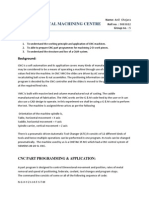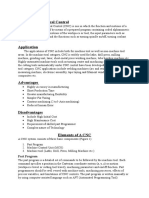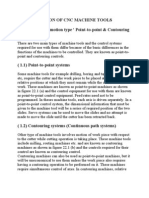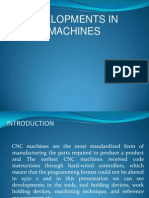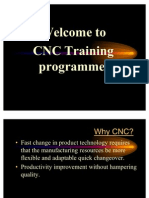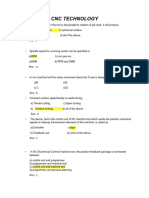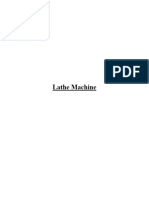Tools and Work Holding Devices of CNC Machines
Tools and Work Holding Devices of CNC Machines
Uploaded by
sham javedCopyright:
Available Formats
Tools and Work Holding Devices of CNC Machines
Tools and Work Holding Devices of CNC Machines
Uploaded by
sham javedOriginal Title
Copyright
Available Formats
Share this document
Did you find this document useful?
Is this content inappropriate?
Copyright:
Available Formats
Tools and Work Holding Devices of CNC Machines
Tools and Work Holding Devices of CNC Machines
Uploaded by
sham javedCopyright:
Available Formats
Tools And Work Holding Devices of Cnc Machines
What is tool?
A tool is any instrument or simple piece of equipment that you hold in your hands
and use to do a particular kind of work. For example, spades, hammers, and knives
are all tools.
Difference between CNC and Conventional Machine:
1. CNC machines can be used continuously for long intervals and only need to be
switched off for occasional maintenance. Conventional machines are difficult to
operate for several hours at a stretch. the operator has to continuously focus on the
job at hand.
2. CNC machine can produce several products all similar and deadly accurate. The
resemblance of the products formed depends on the skill of the operator. A visible
difference may occur.
3. Less skilled or trained persons can easily operate CNC machines. It requires
highly skilled operators to work on conventional machines.
4. The software to drive the machines usually updates the CNC machine process.
Chances for a major improvement in the same conventional machines are very less.
5. One person can supervise several CNC machines, and they can be left to work
themselves. One person cannot operate one CNC machine at a time.
Tools Of Cnc Machines:
The use of computers to control cnc machine
tools. Tool include lathes, mills, drills. Machine tools function through numerical
control. A computer program is customized for an object and the machines are
programmed with CNC machining language (called G-code).
Content of 1st Part of topic
Types of Tool materials
Types of Cutting tools
CNC Milling tools
CNC Turning tools
CNC Drills
Insert
ATC & Turret Head
Types of Tool Material:
There are different type of following materials used for tool.
High Speed Steel (HSS) (18% Tungsten, 4% chromium, 1% vanadium, 0.7%
Carbon )
High Carbon Steel (HCS) (0.6-1% carbon, 0.6-0.9% manganism, 97% iron )
Cast Alloy (10% chromium, 15% manganism, 75% stainless steel )
Cemented Carbide (Cemented carbide tips used )
Ceramic (Alumina (Al2O3) and silicon nitride (SiN) )
Diamond (Super hard materials )
Cnc Milling Tools:
CNC milling, or computer numerical control milling, is a
machining process which employs computerized controls and rotating multi-point
cutting tools to progressively remove material from the workpiece and produce a
custom-designed part or product. This process is suitable for machining a wide
range of materials, such as metal, plastic, glass, and wood, and producing a variety
of custom-designed parts and products.
Various type of milling tool:
End mill:
End mills can take many forms, they typically have sharp cutting
flutes on the ends and sides, and can be used in various cutting applications:
Flat end mill:
Flat end mills are used for roughing operations, cutting 2D shapes
like engravings and circuit boards, and flat-sided 3D shapes. You can use these
carbide end mills to cut a square edge into metal, wood, wax, and plastic.
Bull Nose End Mills (Corner Radius):
Bull end mills are simply corner radius
end mill cutters. These radius end mills are single ended tools used for making
corner radii at the bottom of a milled shoulder. Corner radius end mill cutters have
a stronger milling edge than square end mills, so feed rates may be increased and
yield longer tool life and greater productivity. These milling bits may also be used
in mold profiling applications with greater productivity than ball end mills. These
mills are all solid carbide, and are available in many diameter sizes and lengths.
Tapered end mill
Tapered End Mills are highly functional general-purpose
cutting tool for cutting angled slots into molds and dies. Unlike standard end mills,
tapered end mills are wider at the base than the tip, and the conical shape allows
for milling operations in deeper cavities and at harder to accommodate angles.
Plus, tapered end mills offer increased strength over the typical straight reach
cutting tool. Order your custom tools through Valley Tool Inc. today for tooling
with unmatched accuracy and precision, designed with the fastest, most
competitive lead times in the industry.
T-slot tool:
T-slot use for creation of t slot on work piece suface in milling
operation with horizontal and vertical operation.
Chamfer tool:
Chamfer tool use for creation of 45 degree on sharp edge of wokpiece
Taps tool generate thread in cylindrical hole
Cnc Turning Tool:
Turning is a machining process in which a cutting
tool, typically a non-rotary tool bit, describes a helical tool path by moving more or
less linearly while the work piece rotates.
Cnc Drilling Tool:
Drilling is a process of producing a round holes in a solid
material or enlarging a existing holes with the use of multi-tooth cutting tools
called drills or drill bits. Various cutting tools are available for drilling, but the
most common is the twist drill.
Insert Tools:
Inserts are removable cutting tips, which means they are not
brazed or welded to the tool body. They are usually index able. This saves time in
manufacturing by allowing fresh cutting edges. The strength of the inserts also
depends upon the shape of the insert.
ATC & Turret Head:
An automatic tool changer often referred to as an
ATC, is used to improve both the production and the tool carrying capacity of a
computerised numerical control or CNC machine tool. It does this by allowing the
machine to work with various different tools. As such it is part of the process to
achieve full automation.
An automatic tool changer is generally comprised of a base, arms with a gripper, a
tool holder and a support arm as well as the tool magazines. An ATC is capable of
increasing the speed and accuracy as well as the reliability of a CNC machine but it
does have certain requirements. Some of these include the need for the tools to be
easy to centre as well as simple for the grabber arm to hold as well as easy to
automatically disengage. To provide this, tools used in an ATC are usually held by
specially designed tool holders.
Turret head
Turret head is a large circular or polygonal disc for holding
various tools for different operations, mounted on a gearbox type closed body
having a spindle and gear arrangement driven by an electric or hydraulic motor
which will cause indexing of disc to position the tool in operating point.
Work Holding Devices:
CNC machine tools frequently operate at greater feed rates and speeds than those
used in conventional machining, so larger forces may be applied to the component
and therefore to the clamping or holding devices. As the programmer, it is part of
your task to decide what type of work-holding device is required for a particular
operation.
Over view Of 2nd Part Of topic
Types of Holding Devices
T slot table
Rotary Table
Different type of Chucks
Different types of vice & clamps
Work Holding Devices Characteristics
Work holding devices must have required accuracy and must have matching
reference surfaces with the reference system.
Work holding devices are allowed to perform a number of operations on
different faces in a single setting.
Work holding devices must enable quick loading and unloading.
Work holding devices must be fool-proofing to avoid incorrect loading of
the job.
Work holding devices must be sufficient rigidity to fully withstand the
cutting forces.
T Slot Table:
T-Slots are by far the most common way of positioning and
holding down your Work holding solution. They are simple, robust, and they work.
To attach something to a T-Slotted table, use T-Slot nuts and suitable studs or other
fasteners that fit the nuts.
Rotary Table & 5 Axis Swivel Table:
A rotary table is a precision work
positioning device used in metalworking. It enables the operator to drill or cut
work at exact intervals around a fixed (usually horizontal or vertical) axis.
5-Axis work holding, like most things 5-axis, is a whole other
world. I won’t go into any detail here other than to say you need different kinds of
work holding when you can access a part from virtually any direction.
Different Types Of Vice & Clamps:
Double Milling Vise:
Having spread three or four vises across your mill table,
you’ve pretty well taken advantage of the X-Axis. But, there’s an opportunity to
take better advantage of the Y-Axis by using Double Vises.
Step Clamps:
The most common type of clamps are called step clamps because
they have little steps machined on them. They’re commonly used with T-Slots,
although you can also use bolt them into a Tooling Plate. Here are some typical
Step Clamp
Pneumatic Clamps & Vacuum Table:
Pneumatic Clamps:
pneumatic clamps working through high pressure compressed
air. Pneumatic Clamps (short stroke and positional) are smart time-saving elements
used when flexibility and short cycle times are required.
Vacuum Clamps:
Vacuum table CNC work holding is designed to swiftly and
efficiently secure flat work pieces to the bed of a machining system. Thin stock,
which could be secured only with great difficulties before, is now secured literally
within seconds. Quickly secure plastic foils as thin as 0.001”, to 0.250” large
aluminum sheets.
You might also like
- G & M CodesDocument2 pagesG & M Codespsathishthevan100% (3)
- NIMS CNC Operators Supplement-Pretest Study Guide - 3Document13 pagesNIMS CNC Operators Supplement-Pretest Study Guide - 3budayaNo ratings yet
- 1.5 Practice Questions & Answers - 1 PDFDocument5 pages1.5 Practice Questions & Answers - 1 PDFMega Games50% (2)
- Putting A Price Tag On LifeDocument4 pagesPutting A Price Tag On LifeKenji LogieNo ratings yet
- Manual Part ProgrammingDocument38 pagesManual Part ProgrammingHot Shot100% (1)
- CNC LAB Manual PDFDocument33 pagesCNC LAB Manual PDFrajee10150% (4)
- CNC Programs ExamplesDocument5 pagesCNC Programs ExamplesNemikumar Gandhi100% (3)
- Machine Tools Questions and Answers - GrindingDocument4 pagesMachine Tools Questions and Answers - GrindingRohit Ghulanavar100% (1)
- Fanuc Ot CNC Program Manual Gcodetraining 588Document104 pagesFanuc Ot CNC Program Manual Gcodetraining 588hiepkhachbk2010824350% (2)
- MCQ On CNC MachineDocument3 pagesMCQ On CNC Machinecbeprabhugmail100% (2)
- UNIT-1 Locating and Clamping: S.Dharani KumarDocument86 pagesUNIT-1 Locating and Clamping: S.Dharani KumarSaivineeth Gampa100% (1)
- Vertical Machining Centre (VMC)Document3 pagesVertical Machining Centre (VMC)anil chejara100% (1)
- Tools & Work Holding Devices in CNC MachinesDocument17 pagesTools & Work Holding Devices in CNC MachinesAhtisham AmjadNo ratings yet
- Viva Voce Questions: CNC MachinesDocument4 pagesViva Voce Questions: CNC MachinesguruNo ratings yet
- Part Programming For CNC MachinesDocument36 pagesPart Programming For CNC MachinesMuthuvel M100% (2)
- Module 5 TOOLING and WORK HOLDING DEVICESDocument17 pagesModule 5 TOOLING and WORK HOLDING DEVICESsiddharth100% (1)
- Chapter3 - Cutting Tools For CNC MachinesDocument46 pagesChapter3 - Cutting Tools For CNC MachinesTharun Kumar Chõwdâry100% (1)
- CNC Turning CentreDocument10 pagesCNC Turning CentreArun100% (1)
- Classification of CNC MachineDocument11 pagesClassification of CNC Machineaqtu12fuc81% (16)
- Basic Machine Codes PDFDocument31 pagesBasic Machine Codes PDFsabiha12No ratings yet
- Computer Aided Part ProgrammingDocument19 pagesComputer Aided Part ProgrammingPiyush Aggarwal100% (4)
- CNC Turning Programming Exellent ExplainationDocument29 pagesCNC Turning Programming Exellent ExplainationschrienerNo ratings yet
- Programming MillDocument81 pagesProgramming MillEddy ZalieNo ratings yet
- Unit 3 CNC Machine Tools: StructureDocument17 pagesUnit 3 CNC Machine Tools: StructureRohit GhulanavarNo ratings yet
- CNC Milling MCQDocument5 pagesCNC Milling MCQsharad jamkhandikar100% (2)
- NC & CNC MachinesDocument12 pagesNC & CNC MachinesRenjith Rajendraprasad100% (1)
- CNC Part A PDFDocument25 pagesCNC Part A PDFAKSHAY NambiarNo ratings yet
- MT3493 Question Bank - MechDocument34 pagesMT3493 Question Bank - Mechmohan kumarNo ratings yet
- CNC MachineDocument16 pagesCNC MachinePratikChachareNo ratings yet
- Broaching (1)Document16 pagesBroaching (1)patel ketan82% (11)
- CNC Turning Center ProgrammingDocument29 pagesCNC Turning Center ProgrammingSrinivas Yadav100% (1)
- Workshop Technology Question BankDocument3 pagesWorkshop Technology Question BankKamalakanta Sahoo100% (2)
- CNC Insert DesignationsDocument18 pagesCNC Insert DesignationsNemikumar Gandhi100% (2)
- Classification of NCDocument9 pagesClassification of NCAmarnadh60% (5)
- Fine Boring & Jig BoringDocument12 pagesFine Boring & Jig Boringshiva100% (1)
- Study of Sine BarDocument6 pagesStudy of Sine BarMaria Mehar100% (2)
- CNC Technology 2 MarksDocument10 pagesCNC Technology 2 Markssivaeinfo0% (1)
- Lecture 5 Heat Generation in Metal Cutting OperationsDocument36 pagesLecture 5 Heat Generation in Metal Cutting Operationsnickokinyunyu11No ratings yet
- 50 Questions and Answer: Milling Machine (Milling Machine) Is A Machine Tool That Is in The ProcessDocument4 pages50 Questions and Answer: Milling Machine (Milling Machine) Is A Machine Tool That Is in The ProcessZul FakriNo ratings yet
- Chapter 3.Cnc Part ProgrammingDocument61 pagesChapter 3.Cnc Part Programminghari0118No ratings yet
- An Introduction To CNC MachinesDocument20 pagesAn Introduction To CNC MachinesBHAVESHNo ratings yet
- Circular Interpolation Programming Example 123456Document14 pagesCircular Interpolation Programming Example 123456Kennaa Gadaa100% (1)
- NC, CNC & DNCDocument135 pagesNC, CNC & DNCchouguleonkar50% (10)
- CNC Programming PresentationDocument150 pagesCNC Programming PresentationVaibhav Vithoba Naik50% (4)
- Economics of Machining 1Document12 pagesEconomics of Machining 1rudrayadav030101No ratings yet
- Explain The Parts of The NC Machine/ Explain The Block Diagram of NC Machine. (3/4 Marks)Document5 pagesExplain The Parts of The NC Machine/ Explain The Block Diagram of NC Machine. (3/4 Marks)rajeshNo ratings yet
- CNC Technology-Objective Questions - Unit3Document2 pagesCNC Technology-Objective Questions - Unit3Anonymous YkDJkSq56% (9)
- CNC Technology and CNC Programming: Integrated Manufacturing SystemsDocument137 pagesCNC Technology and CNC Programming: Integrated Manufacturing SystemsDavid RodriguezNo ratings yet
- Exam Paper On Design of Machine ToolsDocument8 pagesExam Paper On Design of Machine ToolsCharles Ondieki100% (2)
- CNC Part ProgrammingDocument61 pagesCNC Part ProgrammingrajaNo ratings yet
- APT ProgrammingDocument62 pagesAPT ProgrammingAkhil Chappidi100% (3)
- CNC ProgrammingDocument27 pagesCNC ProgrammingAbhijit BiswasNo ratings yet
- Objective2 CADCAM 2019-20Document1 pageObjective2 CADCAM 2019-20Rajyalakshmi MNo ratings yet
- 2D - TransformationDocument95 pages2D - TransformationShubhamNo ratings yet
- CNC Technology MCQDocument36 pagesCNC Technology MCQAkash100% (1)
- Milling and Machining CentersDocument5 pagesMilling and Machining CentersJose JulianNo ratings yet
- DV09PUB2 Study GuideDocument5 pagesDV09PUB2 Study GuideAmirAmiriNo ratings yet
- Uses of CNC Lathe MachineDocument3 pagesUses of CNC Lathe MachineKhairul IkhwanNo ratings yet
- MillingDocument5 pagesMillingSelan MatlanNo ratings yet
- Lathe Machine.Document12 pagesLathe Machine.PUBLIC USERNo ratings yet
- Note CNC Lathe MachineDocument19 pagesNote CNC Lathe MachineSyafi NafisNo ratings yet
- Tools For Conditioning and MonitoringDocument14 pagesTools For Conditioning and Monitoringsham javedNo ratings yet
- Fauji Cement Co. LTD & Askari Cement LTD: Application Form - Apprenticeship 2021Document2 pagesFauji Cement Co. LTD & Askari Cement LTD: Application Form - Apprenticeship 2021sham javedNo ratings yet
- DAE Mechanical and EngineerDocument1 pageDAE Mechanical and Engineersham javedNo ratings yet
- Mechatronic Devices and Systems - MSCDocument2 pagesMechatronic Devices and Systems - MSCsham javedNo ratings yet
- DAE MechanicalDocument1 pageDAE Mechanicalsham javedNo ratings yet
- Vibration Diagnosis Control FinalDocument19 pagesVibration Diagnosis Control Finalsham javedNo ratings yet
- Introduction To Non Conventional OperationsDocument13 pagesIntroduction To Non Conventional Operationssham javed100% (1)
- DAE MechanicalDocument1 pageDAE Mechanicalsham javedNo ratings yet
- MT-473, Health, Safety Past Paper SolutionDocument14 pagesMT-473, Health, Safety Past Paper Solutionsham javedNo ratings yet
- Muhammad Zeeshan Roll No 18 (Autosaved)Document14 pagesMuhammad Zeeshan Roll No 18 (Autosaved)sham javedNo ratings yet
- CA FINAL LAW Additional Questions May 2021Document108 pagesCA FINAL LAW Additional Questions May 2021Aneek JainNo ratings yet
- MethaneDocument22 pagesMethaneAssassin's j :uNo ratings yet
- Marketing Excellence 2 Mcdonalds (Brand Revitalisation) Case Study PDFDocument11 pagesMarketing Excellence 2 Mcdonalds (Brand Revitalisation) Case Study PDFBalraj Jain0% (1)
- Community Development - PresentationDocument14 pagesCommunity Development - Presentationblah blah 56743No ratings yet
- View - Print Submitted FormDocument2 pagesView - Print Submitted FormNikhil DongareNo ratings yet
- Bruno Mölder On Philosophical Models of Time PerceptionDocument10 pagesBruno Mölder On Philosophical Models of Time PerceptionJaviKreynNo ratings yet
- Gourami (Osphronemus Goramy) : Ecological Risk Screening SummaryDocument17 pagesGourami (Osphronemus Goramy) : Ecological Risk Screening SummaryFANOMEZANTSOA Nantenaina PatrickNo ratings yet
- Feaoe2000 PDFDocument1 pageFeaoe2000 PDFAnkitNo ratings yet
- March 28, 2022: Lesson Plan in Grade VI Health ViDocument4 pagesMarch 28, 2022: Lesson Plan in Grade VI Health ViLEONY TENDERO100% (1)
- (Year) : Executive SummaryDocument26 pages(Year) : Executive Summaryashishkhatu1No ratings yet
- Triangle CongruenceDocument18 pagesTriangle CongruenceJumedeluna05yahoo.com Jumelynjumelyn199411No ratings yet
- Iec TR 61491-2010Document22 pagesIec TR 61491-2010hertorNo ratings yet
- IFY Chemistry Syllabus 2022-23 v3.2Document42 pagesIFY Chemistry Syllabus 2022-23 v3.2Torera GloverNo ratings yet
- Rule 39, Sec.5 - Aranda Vs CADocument3 pagesRule 39, Sec.5 - Aranda Vs CAJL A H-Dimaculangan100% (1)
- Grade 11 Revision QuestionsDocument12 pagesGrade 11 Revision QuestionsSaheed AbdulkarimNo ratings yet
- Organic Chemistry AtomicDocument13 pagesOrganic Chemistry AtomicJasmin SauraNo ratings yet
- (Kunci) Soal Sas Genap Bahasa Inggris Kelas Xi 2024Document6 pages(Kunci) Soal Sas Genap Bahasa Inggris Kelas Xi 2024khayrunaa3No ratings yet
- Uman Esource Anagement: An Experiential ApproachDocument15 pagesUman Esource Anagement: An Experiential Approachbipul84No ratings yet
- Rural Postal Life Insurance Intro Eligibility FeaturesDocument3 pagesRural Postal Life Insurance Intro Eligibility Featuresbibhuti bhusan routNo ratings yet
- Dry - 20-130 ManualDocument12 pagesDry - 20-130 ManualTina ManousiNo ratings yet
- Zentraldoku Jade Standard EDocument160 pagesZentraldoku Jade Standard Emahmoud alraoushNo ratings yet
- Your Transformation: The 10 Principles of TransformationDocument1 pageYour Transformation: The 10 Principles of TransformationSheila EnglishNo ratings yet
- The Companies Act 2015Document3 pagesThe Companies Act 2015Anungo KaveleNo ratings yet
- Mock BudgetDocument4 pagesMock Budgetapi-253303059No ratings yet
- Advocate Manoj Yadav in Dwarka Delhi India - Tax Advocate IndiaDocument4 pagesAdvocate Manoj Yadav in Dwarka Delhi India - Tax Advocate IndiavikasNo ratings yet
- The Fundamentals of Regression Analysis PDFDocument99 pagesThe Fundamentals of Regression Analysis PDFkatie farrellNo ratings yet
- WHO Guidelines - Adverse EventsDocument80 pagesWHO Guidelines - Adverse Eventsdrabhi23No ratings yet
- Victorias Planters Vs Victorias Milling CoDocument5 pagesVictorias Planters Vs Victorias Milling CoJec Luceriaga BiraquitNo ratings yet
- Notice For Selected Results Main List Fall 2023 - 25 July 2023 - For Publication - v3Document202 pagesNotice For Selected Results Main List Fall 2023 - 25 July 2023 - For Publication - v3Amit baraiNo ratings yet











